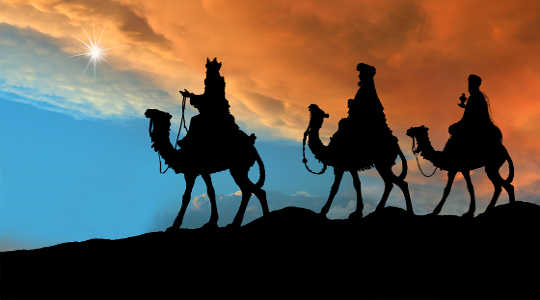
Picturesque and exotic, with their crowns and camels, the three kings regularly appear on Christmas cards and in nativity scenes. But how much is original, and how much is later addition for the sake of a good story?
All we know is what Matthew’s gospel tells us, and that does not include their number. They brought gifts of gold, frankincense and myrrh, but to suppose that three gifts means three givers is no more than a guess. More importantly, they were not kings. In his account Matthew consistently describes the visitors as magoi which is the same as the English word “mage”. It’s an unusual word and is often translated as “wise men”.
The early church upgraded them to royal status, perhaps because of descriptions in Isaiah 60 and Psalm 72 of kings worshipping the messiah – but Matthew himself, whose gospel is full of references back to the psalms and prophets, does not make this link, and he would never have let such an opportunity drop.
What they saw
They had seen a star, which shows they were astronomers – or astrologers as there was no difference back then. What was this star? Some scholars have posited that in 7BC there was a triple conjunction (when the planets catch up and overtake each other: quite a dramatic sight) of Jupiter and Saturn, in the constellation of Pisces. These three elements were linked in astrology to royalty, the messiah and the Jews respectively.
Some astronomers, for example Patrick Moore, are unhappy with this theory and suggest that the star the wise men followed was a nova, a comet, or meteors. But there is no firm evidence for any of these. They point out that conjunctions are rare but not unique, and ask why were there no emissaries to Israel on other occasions. Perhaps there were – we only have this single record because of its link to the larger story.
I think what really worries them is that if you accept this interpretation it implies accepting the validity of astrology, and today’s astronomers really hate astrologers (never ask an astronomer what their star sign is). But you don’t have to. Even the sceptical can accept that a visit to Jerusalem and Bethlehem by foreigners looking for the messiah would have made a good story which would be told and retold – and eventually get attached to the birth of Jesus. Matthew wrote his gospel for a Jewish readership, and the Jewish religion then was hostile to astrology, so the suggestion that he just made up the story as propaganda is implausible.
A familiar approach
We can imagine the situation. The star was not a surprise: conjunctions are predictable – today lists of upcoming ones are available on the internet – and even if this was not available 2,000 years ago, astronomers then made careful observations on which they could make predictions using geocentric theories which were fundamentally wrong but which nevertheless seemed to work.
For months and years beforehand the “wise men” will have discussed and organised the expedition: the practicalities, the funding. We know how they must have felt, planning a project, looking for money to pay for it, arguing whether their theory’s predictions were really firm or could have some other interpretation.
At this point we realise that we have a better word to translate magoi – a word not available to the translators of the Authorised Version of the Bible in King James’ reign, as it was only invented in 1833.
The word is scientists.
Looking back 2,000 years, they and we are not so different. They used their understanding of the universe to predict what would happen in the world – and, working as a group, they investigated their predictions, despite the cost and trouble and hardships. This is something any scientist today can recognise and identify with. Their understanding of the universe is crude and primitive in our eyes – but what will today’s scientific theories look like in 2,000 years time?
So, when we see pictures of the three kings at Christmas, we should spare them a thought, as colleagues who believed in their theories and followed through the consequences, despite the trouble and expense and personal effort involved. The strength of their conviction and their resolution to follow it, 2,000 years ago, can be an example to us today.
![]()
About The Author
Roger Barlow, Research Professor and Director of the International Institute for Accelerator Applications, University of Huddersfield
This article was originally published on The Conversation. Read the original article.
Related Books
at InnerSelf Market and Amazon

























